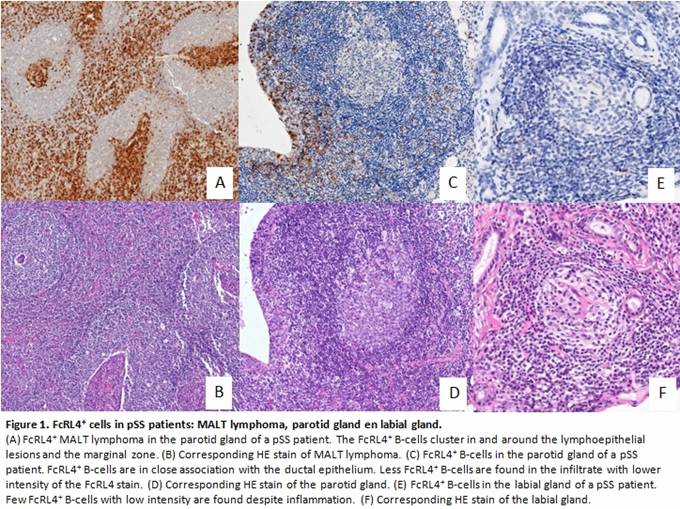Session Information
Session Type: ACR Plenary Session
Session Time: 11:00AM-12:30PM
Background/Purpose:
Patients with primary Sjögren’s Syndrome (pSS) have an increased risk of
non-Hodgkin’s lymphoma, predominantly of the Mucosa Associated Lymphoid Tissue
(MALT) type, which commonly occur in the parotid glands. MALT lymphomas in
general, express Fc receptor-like 4 (FcRL4/IRTA1/CD307d)1.
Normally FcRL4 is expressed on a very small subset of mucosa-associated
B-cells. FcRL4+B-cells might be closely related to the MALT lymphoma
cells. Therefore, we assessed whether FcRL4+B-cells are present in
the inflamed salivary gland tissue of pSS patients, and whether these cells are
targeted by biological therapy.
Methods:
Forty
nine parotid gland MALT lymphomas, 30 parotid gland biopsies, 24 labial gland
biopsies and parotid gland biopsies before and after treatment with rituximab
(18 patients) or abatacept (15 patients), all obtained from pSS patients, were
stained for FcRL4 expression. As control served parotid gland biopsies of 8 non-pSS
sicca patients and 5 non-sicca patients. FcRL4 mRNA was isolated from 8 non-pSS
sicca patients, 9 pSS patients and 11 pSS MALT lymphoma patients.
Results:
Nearly all (96%) parotid
gland MALT lymphomas expressed FcRL4 (Fig. 1). Low numbers of FcRL4+B-cells
were detectable in parotid glands of most (90%) pSS patients. Intensely stained
FcRL4+B-cells were in close relation to lymphoepithelial lesions
with some FcRL4+B-cells within the surrounding infiltrate. Even
lower numbers of FcRL4+B-cells were discernible in the labial
glands. Levels of FcRL4 were significantly increased in parotis gland tissue of
pSS patients, compared to non-pSS sicca patients. These levels further
increased significantly in pSS patients with MALT lymphomas in the parotid
glands. Treatment with rituximab significantly
reduced the number of FcRL4+B-cells in the parotid glands, whereas
abatacept treatment did not affect FcRL4+B-cells in the
glandular tissue (Fig. 2).
Conclusion:
FcRL4+B-cells
are found in the salivary glands of pSS patients and are likely the cells from
which MALT lymphomas arise. The observation that FcRL4+B-cells are
enriched in the parotid glands may explain why MALT lymphomas preferentially
develop in these glands. Our treatment studies reveal that FcRL4+B-cells
can be targeted by anti-CD20 therapy and that these cells are maintained in a CD28-
independent manner.
References
1.
Falini B. et al. IRTA1 is
selectively expressed in nodal and extra nodal marginal zone lymphomas. Histopathology.
2012 Nov 61(5):930-41.
To cite this abstract in AMA style:
Haacke EA, Kroese FGM, Kluin P, Meiners PM, Visser A, Spijkervet FKL, Bootsma H. Salivary Gland FcRL4+ B-Cells Are a Potential Source of Progenitor Cells for MALT Lymphoma in Primary Sjögren’s Syndrome [abstract]. Arthritis Rheumatol. 2015; 67 (suppl 10). https://acrabstracts.org/abstract/salivary-gland-fcrl4-b-cells-are-a-potential-source-of-progenitor-cells-for-malt-lymphoma-in-primary-sjogrens-syndrome/. Accessed .« Back to 2015 ACR/ARHP Annual Meeting
ACR Meeting Abstracts - https://acrabstracts.org/abstract/salivary-gland-fcrl4-b-cells-are-a-potential-source-of-progenitor-cells-for-malt-lymphoma-in-primary-sjogrens-syndrome/


